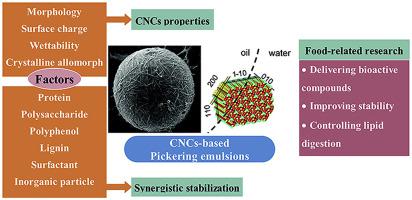Trends in Food Science & Technology ( IF 15.1 ) Pub Date : 2020-06-07 , DOI: 10.1016/j.tifs.2020.05.016 Hongjie Dai , Jihong Wu , Huan Zhang , Yuan Chen , Liang Ma , Huihua Huang , Yue Huang , Yuhao Zhang

|
Background
Pickering emulsions stabilized by solid particles have captured a growing interest recently due to their outstanding stability. Among various solid stabilizers, cellulose nanocrystals (CNCs) mainly from agricultural and forestry wastes have emerged as promising materials in Pickering emulsions application due to their favorable properties such as nanostructure, high aspect ratio, biocompatibility, amphiphilicity, low toxicity, and renewability.
Scope and approach
In this review, the source and extraction methods of CNCs are summarized briefly. Then, the recent advances in CNCs stabilized Pickering emulsions are highlighted, including the factors affecting the emulsification performance of CNCs itself and the synergistic effect induced by other substances. Furthermore, the food-related research, safety issue and the promising research trends of CNCs stabilized Pickering emulsions are also outlined.
Key findings and conclusions
The properties of CNCs mainly depend on the cellulose sources and extraction processes. The morphology, surface charge, wettability and crystalline allomorph of CNCs can influence emulsifying ability as Pickering stabilizers. The synergistic effect induced by other substances (i.e. polysaccharide, protein, polyphenol, lignin, surfactant, and inorganic particle) increases potential of CNCs in Pickering emulsions application. The food-related research of CNCs stabilized Pickering emulsions currently focuses on delivering bioactive compounds, improving stability and controlling lipid digestion. Future studies could devote more efforts to effective and green extraction of CNCs, revealing stabilization mechanism in a multicomponent system and developing functional applications of CNCs-based Pickering emulsions. In addition, the safety assessment involving CNCs and their stabilized emulsions deserves more attention for food-related applications.
中文翻译:

用于Pickering乳液的纤维素纳米晶体的最新进展:发展与挑战
背景
由于其出色的稳定性,最近由固体颗粒稳定的Pickering乳液引起了越来越多的关注。在各种固体稳定剂中,主要来自农业和林业废物的纤维素纳米晶体(CNC)已成为Pickering乳液应用中有希望的材料,因为它们具有良好的性能,例如纳米结构,高长宽比,生物相容性,两亲性,低毒性和可再生性。
范围和方法
在这篇综述中,简要概述了CNC的来源和提取方法。然后,重点介绍了CNCs稳定的Pickering乳液的最新进展,包括影响CNCs本身的乳化性能以及其他物质引起的协同效应的因素。此外,还概述了食品相关的研究,安全性问题以及CNCs稳定的Pickering乳液的有前途的研究趋势。
主要发现和结论
CNCs的性质主要取决于纤维素来源和提取过程。CNC的形态,表面电荷,润湿性和结晶同素异形体会影响作为Pickering稳定剂的乳化能力。其他物质(例如,多糖,蛋白质,多酚,木质素,表面活性剂和无机颗粒)引起的协同作用增加了CNC在Pickering乳液应用中的潜力。与CNCs稳定的Pickering乳液的食品相关研究目前集中在提供生物活性化合物,提高稳定性和控制脂质消化方面。未来的研究可能会更多地致力于有效,绿色地提取CNCs,揭示多组分系统中的稳定机制并开发基于CNCs Pickering乳液的功能应用。此外,











































 京公网安备 11010802027423号
京公网安备 11010802027423号